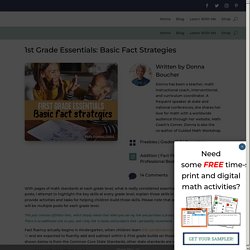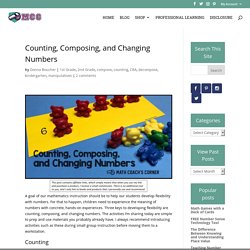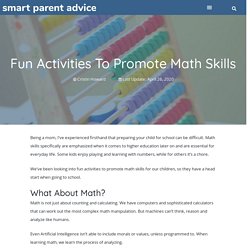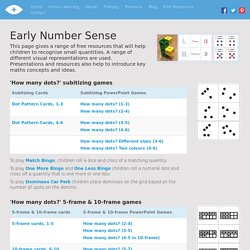

1st Grade Essentials: Basic Fact Strategies. With pages of math standards at each grade level, what is really considered essential learning?

In this series of posts, I attempt to highlight the key skills at every grade level, explain those skills in layman’s terms, and provide activities and tasks for helping children build those skills. Please note that as this series grows, there will be multiple posts for each grade level. This post contains affiliate links, which simply means that when you use my link and purchase a product, I receive a small commission. Twitter. Twitter. 3 Recommendations for Supporting Early Elementary Students Remotely. I didn’t know my “last day” of in-person teaching with my students was going to be my last day.

Like most teachers, I didn’t have a chance to say any kind of a special goodbye let alone send home books, activities, or detailed plans for how we’d continue to learn together. But in the past couple of weeks, my colleagues and I have learned a lot about how we can connect with and teach 75 five-year-olds remotely. We certainly don’t have this all figured out, but I’d like to share some of the things that have worked for us! Counting, Composing, and Changing Numbers. A goal of our mathematics instruction should be to help our students develop flexibility with numbers.

For that to happen, children need to experience the meaning of numbers with concrete, hands-on experiences. Fun Activities To Promote Math Skills - Smart Parent Advice. Daily Activities Have your child put a designated number of oranges or apples in your grocery bag when shopping, or have them count the number of buttons on a shirt as you close them.

Kristen kilcommins sur Twitter : "One activity on this weeks distance learning board asked children to “show” numbers in a variety of ways. This picture was sent to me from one of my Kindy families. □□ @Inv3_Math @BlanchardMem @mrshainesmath @SharonRyan34. Fun Activities To Promote Math Skills - Smart Parent Advice. Just put this together for my kindergarten teachers and thought I'd share it. Help yourself! #iteachmath #elemmathchat #Kinderchat. Pocket Chart Number Cards to 1,000. You can thank my girl Keisha for tonight’s freebie.

My second grade teachers are working on numbers up to 1,000, and Keisha sashayed into my room today with this GREAT idea! Wouldn’t it be cool to have number cards for the hundreds pocket chart that went beyond 100…say, up to 1,000? Oh yeah, I said, that would be so awesome! You had to know what was coming next. So tonight I have for you the perfectly sized cards (2 x 2, for your information) to fit into your hundred pocket chart. I think Keisha owes me another photo session with her amazing anchor charts, don’t you think!! CRA for Composing and Decomposing Numbers. Okay, I’m having trouble finding different ways to say “composing and decomposing numbers” in my post titles! But seriously, it’s just THAT important, so I keep writing about it.
Our Kinders and Firsties should be doing these types of activities extensively, so it’s important to find lots of different ways to approach the skill. Today I present Clothespin Count. Students use strips that have dots showing 5 (pictured below) through 10. Choose the number that your kiddos need to work on. Like the number cards shown in the pictures? 10 Easy Ways to Teach Subitizing. So What is Subitizing?

Subitizing is the ability to instantly recognize the amount of objects without actually counting them. When I was a young teacher, Math Their Way was THE math curriculum. Math Their Way is where I learned about the importance of teaching subitizing. Mary had this game called "Say it Fast". To play the game you quickly flashed a card with a set of dots. How Digital Tools Can Help Make Math Visual. What do you suppose was going through this child’s head when she went back for more bowls?

It’s highly doubtful that at 2 years old she was thinking “Six dogs minus four bowls means I need to add two more bowls.” So how was she able to know exactly how many more bowls she needed? The answer lies in her spatial awareness and spatial reasoning. Although the context may vary wildly from child to child, young learners have “foundational experiences” (Clements & Sarama, 2004) like the one described above all the time and it demonstrates the role spatial reasoning plays in their cognitive development – but this anecdotal evidence is far from the full story.
Video showing the hiding assessment to assess proficiency with composing/decomposing numbers. The Progression of Early Number and Counting. Principles of Counting & Quantity Cheat Sheet v2.pdf. Number Sense Routines - 2019 K-1 (1).pptx. Handy Ten Frame Placemat with Number Sense Routines. Last week I spent two days in sunny Avon Park, FL, working with teachers from Avon Elementary.

It was a real treat because I finally got to meet and spend time with my previously-cyber-friend turned flesh-and-blood-friend, Sara! She was such a gracious hostess and made me feel right at home. Sara and her friend Kelly took me out to dinner one night, and we talked about…what else…MATH. They shared a neat routine that they used last year, and I wanted to share it. Counting Principles - Counting, Quantity and Cardinality. Freebie for Composing and Decomposing Numbers. My firsties are working on composing and decomposing numbers, specifically the number 5, and today we played a tried and true game, Under a Rock.

I had teddy bear counters to use, and I decided right then and there that In the Cave would be a lot more fun than Under a Rock. We used the Under a Rock recording sheet and adapted it, but I came right home, found some cute bear clipart from , and In the Cave was born! This post contains affiliate links, which simply means that when you use my link and purchase a product, I receive a small commission.
There is no additional cost to you, and I only link to books and products that I personally recommend. Here’s the lowdown. CRA for Composing and Decomposing Numbers. Dusti's 100 House. Early Number Sense - I See Maths. Activities The Count On Races game, played by an adult and a child, helps children learn to count on mentally.

A coin or a dice with 1 or 2 on each face is used. Children say the next number when counting on. For example, when starting from 7, for a jump of 2 we say '8,9'. The Cube Model (4-6) and Cube Model Advanced (4-6) tasks, children recreate the models. The Reasoning in Addition Puzzles get children thinking deeply about the value of different shapes. Visual Representations. A Mathemagician's Game for Making Ten. The Path to Unitizing. Do your students still use their fingers or count manipulatives to solve simple math problems? Our goal as teachers is to provide math experiences in which students understand numbers and their relationships in order to solve problems using non count-by-one strategies. Robert J. Wright, et al., 2012, in the book, Developing Number Knowledge, states: "It is critical that students' early arithmetical thinking progresses from being based on counting by ones to being based on structuring numbers.”
Here are some examples of students’ strategies for solving simple addition facts. What's My Number? Differentiating in K-1. I Love Number Lines! Number lines are such an incredibly powerful tool, and I think sometimes they get underutilized. Sure, many (I hope ALL!) Teachers have number lines hanging in their classrooms, but they can be used for so much more than just sequencing numbers from 1 to 100. Last summer, I found a couple of great new books published by Heinemann for teaching basic facts. The addition and subtraction book showed how number lines can be used to help build a foundational understanding of fact families. The example below shows that 2 + 3 and 3 + 2 both equal 5.
I created a cuter version of this activity in my fact families workstation unit. Kindergarten Yahtzee! Be the Teacher: Moving from Counting to Cardinality. Subitizing What is it Why teach it. Rainbow Activities - Planning Playtime. Freebie for Composing and Decomposing Numbers. Changing Numbers. The Main Areas of Early Years Maths: Composition. Knowing numbers are made up of two or more other smaller numbers involves ‘part–whole’ understanding. Learning to ‘see’ a whole number and its parts at the same time is a key development in children’s number understanding. Apps for Making Ten. I walked into a 2nd grade classroom Thursday to find the students busily engaged in math workshop. Several students were working with iPads and playing what looked to be an addictive math game.
I sat myself down and asked them to show it to me. The app, Numbers Logic Puzzle, is a Candy Crush-like game for making ten. QUACK! Composing and Decomposing Numbers. Young Children's Mathematics: Cognitively Guided Instruction in Early Childhood Education (9780325078120): Thomas P Carpenter, Megan Loef Franke, Nicholas C. Johnson, Angela C. Turrou, Anita A Wager: Books. 15 Picture Books That Support Children’s Spatial Skills Development. Composing 10 Online Game. As we wind down to the end of the school year, I’ve been looking for ways to keep my students engaged while still ensuring that each lesson includes worthwhile learning. That’s the tricky balancing act, right?
Early Childhood Math Questioning Strategies. Solving Addition and Subtraction Stories in Kindergarten - Math Coach's Corner. Rekenreks. Making High-Yield Routines Work. 100 Subitizing Slides & 10 Challenge Patterns – Steve Wyborney's Blog: I'm on a Learning Mission. With a click, a pattern of dots appears on your screen. Instantly your students tell how many. They don’t count the dots. Instead they simply know the total at a glance. Subitizing – when a person looks at a small set of objects and instantly detects the total without counting. What Can We Learn From Letter Reversals? – Elementary Mathematics – Round Rock ISD.
Recently my daughter, who is in 1st grade, made this adorable card for my husband: Looking at her card, I immediately saw an error that is all too common with early readers and writers: she has trouble differentiating the letters b and d. PBS LearningMedia. Subitizing. Building Mathematical Competencies in Early Childhood. Engaging Games for Composing and Decomposing Numbers. Part 2: Responding to The Power of Mathematics Learning Trajectories in Early Learning and Primary Classrooms - The Learning Exchange. How Kids Benefit From Learning To Explain Their Math Thinking. Why early math is just as important as early reading. What grade do U.S. preschools deserve in math instruction? Answer: F (At least most of them.) Using Number Bracelets to Develop Number Sense. Changing Numbers. Composing and Decomposing Numbers: Cube Trains. Counting With Your Eyes: The Importance of Subitizing For Developing Math Understanding. Part 1: The Importance of Spatial Reasoning and Geometry in Kindergarten - The Learning Exchange.
It's All In How You Interpret It. Mention common core, and you’ll get a wide range of comments–some supportive and some not so much. I recently read a comment that the common core standards are not developmentally appropriate. The specific standard the author was referring to was the Kindergarten standard stating that students should fluently add and subtract within 5. The One-Handed Clock in a Digital Era. It's All In How You Interpret It. How Many More? Composing And Decomposing Numbers - The Recovering Traditionalist.
Five Compelling Reasons For Teaching Spatial Reasoning To Young Children. Robertkaplinsky. Conquering the Hundred Chart. Engaging Games for Composing and Decomposing Numbers. Math in Early Childhood: 6 Strategies for Teaching Math Throughout the Day. Subitizing: Instantly Recognizing Quantities. Exploring Addition Strategies. Concrete Support for Learning. Calendar Time Must Die - MyNCTM. The Progression of Early Number and Counting. The Progression of Early Number and Counting. Apps for Making Ten. Freebie for Composing and Decomposing Numbers. Using Number Bracelets to Develop Number Sense. Budget-Friendly Preschool Games & Activities. …a child first has to learn the foundational skills of math, like______? PearsonSchoolCanada.ca - Taking Shape. Stanford's Deborah Stipek says we should teach more math in preschool.
Toc. Developing Spatial Reasoning through Guided Play – Thinking Mathematically. Math in the early years. SMP That Help Foster Algebraic Thinking. The Progression of Early Number and Counting.